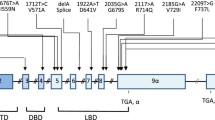Abstract
Both enzyme activity and mRNA concentration of β-glucuronidase were measured in kidneys of mice treated with testosterone and the synthetic estrogen, diethylstilbestrol. Six congenic strains, all having a C57BL6/J genetic background but each having a different haplotype of the β-glucuronidase gene complex, were compared. In each strain the induction caused by androgen was partially repressed by estrogen. The extent of this antagonism varied among the six haplotypes and was not coordinate with the extent of induction by androgen alone. Antagonism appears to be regulated by at least two alleles of a new locus,Gus-e, within the β-glucuronidase gene complex. Repression by estrogen, like induction by androgen, appears to take place primarily at the transcriptional level. Kinetic studies revealed that estrogen causes the androgen response curve to plateau earlier and at a lower level. This suggests that estrogen increases the rate of gene deactivation rather than decreasing the rate of gene activation, Isoelectric focusing of β-glucuronidase fromGus-e a andGus-e b mice and their F1 progeny revealed that the genes are regulated incis. Together, these findings support a model in which both sex hormones exert their effects on separate DNA response elements located in close proximity to the gene or within the gene itself.
Similar content being viewed by others
References
Almagor, H., and Paigen, K. (1988). Chemical kinetics of induced gene expression: Activation of transcription by noncooperative binding of multiple regulatory molecules.Biochemistry 272094.
Beato, M. (1989). Gene regulation by steroid hormones.Cell 56335.
Bracey, L. T., and Paigen, K. (1987). Changes in translational yield regulate tissue-specific expression of β-glucuronidase.Proc. Natl. Acad. Sci. USA 849020.
Bracey, L. T., and Paigen, K. (1989). The N haplotype of the β-glucuronidase gene is altered in both its systemic regulation and its response to androgen induction.Biochem. Genet. 271.
Bullock, L. P., Watson, G., and Paigen, K. (1985). Weak androgen reduces the rate constant of β-glucuronidase induction.Mol. Cell. Endocrinol. 41179.
Bush, R. M., and Paigen, K. (1992). Evolution of β-glucuronidase regulation in the genusMus.Evolution 461.
Cox, R. A. (1968). The use of guanidinium chloride in the isolation of nucleic acids.Methods Enzymol. 12B120.
Ingersoll, D. W., Bobotas, G., Lee, C., and Lukton, A. (1982). β-Glucuronidase activation of latent aggression-promoting cues in mouse bladder urine.Physiol. Behav. 29789.
Jaussi, R., Watson, G., and Paigen, K. (1992). Modulation of androgen-responsive gene expression by estrogen.Mol. Cell. Endocrinol. 86187.
Lusis, A. J., and Paigen, K. (1978). The large scale isolation of mouse β-glucuronidase and comparison of allozymes.J. Biol. Chem. 2537336.
Owens, J. W., Gammon, K. L., and Stahl, P. D. (1975). Multiple forms of β-glucuronidase in rat liver lysosomes and microsomes.Arch. Biochem. Biophys. 166258.
Owerbach, D., and Lusis, A. J. (1976). Phenobarbital induction of egasyn: Availability of egasyn in vivo determines glucuronidase binding to membrane.Biochem. Biophys. Res. Commun. 69628.
Paigen, K. (1989a). Experimental approaches to the study of regulatory evolution.Am. Nat. 134440.
Paigen, K. (1989b). Mammalian β-glucuronidase: Genetics, molecular biology, and cell biology.Prog. Nucleic Acids Res. Mol. Biol. 37155.
Pfister, K., Paigen, K., Watson, G., and Chapman, V. (1982). Expression of β-glucuronidase haplotypes in prototype and congenic mouse strains.Biochem. Genet. 20519.
Pfister, K., Watson, G., Chapman, V., and Paigen, K. (1984). Kinetics of β-glucuronidase induction by androgen: Genetic variation in the first order rate constant.J. Biol. Chem. 2595816.
Pfister, K., Chapman, V., Watson, G., and Paigen, K. (1985). Genetic variation for enzyme structure and systemic regulation in two new haplotypes of the β-glucuronidase gene ofMus musculus castaneus.J. Biol. Chem. 26011588.
Swank, R. T., and Paigen, K. (1973). Biochemical and genetic evidence for a macromolecular β-glucuronidase complex in microsomal membranes.J. Mol. Biol. 77371.
Swank, R. T., Paigen, K., Davey, R., Chapman, V., Labarca, C., Watson, G., Ganschow, R., Brandt, E. J., and Novak, E. (1978). Genetic regulation of mammalian glucuronidase.Recent Prog. Horm. Res. 34401.
Swank, R. T., Moore, K., and Chapman, V. M. (1987). Abnormal subcellular distribution of β-glucuronidase in mice with a genetic alteration in enzyme structure.Biochem. Genet. 25161.
Thomas, P. S. (1980). Hybridization of denatured RNA and small DNA fragments transferred to nitrocellulose.Proc. Natl. Acad. Sci. USA 775201.
Watson, G., and Paigen, K. (1987). Genetic variations in kinetic constants that describe β-glucuronidase mRNA induction in androgen-treated mice.Mol. Cell. Biol. 71085.
Watson, G., and Paigen, K. (1988). in RNA synthesis rates in vivo for androgen-inducible sequences in mouse kidney.Mol. Cell Biol. 82117.
Watson, G., and Paigen, K. (1990). Progressive induction of mRNA synthesis for androgen-responsive genes in mouse kidney.Mol. Cell. Endocrinol. 6867.
Watson, G., Davey, R. A., Labarca, C., and Paigen, K. (1981). Genetic determination of kinetic parameters in β-glucuronidase induction by androgen.J. Biol. Chem. 2563005.
Watson, G., Felder, M., Rabinow, L., Moore, K., Labarca, C., Tietze, C., Vander Molen, G., Bracey, L., Brabant, M., Cai, J., and Paigen, K. (1985). Properties of rat and mouse β-glucuronidase mRNA and cDNA, including evidence for sequence polymorphism and genetic regulation of mRNA levels.Gene 3615.
Wawrzyniak, C. J., Meredith, S. A., and Ganschow, R. E. (1989). Two genetic elements regulate murine β-glucuronidase synthesis following transcript accumulation.Genetics 121119.
Author information
Authors and Affiliations
Additional information
This work was supported with funds from the Schweizerische Stiftung für Medizinisch-Biologische Stipendien, Basel; the Stiftung Professor Dr. Max Cloëtta, Zürich; NIH Grant GM 31656; ACS Grant IRG-1225G; and The Jackson Laboratory.
Rights and permissions
About this article
Cite this article
Watson, G., Jaussi, R., Tabron, D. et al. TheGus-e locus regulates estrogen repression of androgen-induced β-glucuronidase expression in mouse kidney. Biochem Genet 31, 155–166 (1993). https://doi.org/10.1007/PL00020535
Received:
Revised:
Issue Date:
DOI: https://doi.org/10.1007/PL00020535




